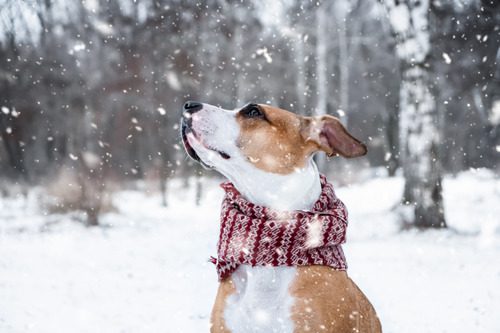Hypothermia in Dogs: Signs and How to Prevent This
Hypothermia in Dogs: Signs and How to Prevent This
Cold weather brings unique challenges for dogs, especially when temperatures drop below freezing. While some breeds are built for winter, others are more vulnerable to the cold, increasing their risk of hypothermia. This dangerous condition occurs when a dog’s body temperature falls too low, affecting their ability to function properly. The team at North Kenny Veterinary Hospital is here to help you understand how hypothermia develops, recognizing the warning signs, and taking preventive steps to help protect your dog from serious health risks. If you’re concerned about your pet’s safety in cold weather, call us (614) 451-1204 or request an appointment online to ensure your dog stays safe this winter.

What Causes Hypothermia in Dogs?
Hypothermia in dogs happens when their body temperature falls below 99°F, preventing their body from functioning normally. This condition is most common in extremely cold environments but can also occur due to prolonged exposure to cool, damp conditions. Several factors increase a dog’s risk of hypothermia:
- Cold temperatures: The lower the temperature, the higher the risk. Dogs left outside in freezing weather are especially vulnerable.
- Wet fur and skin: A wet coat speeds up heat loss, making hypothermia more likely even in moderately cool temperatures.
- Small or short-haired breeds: Dogs with little body fat or thin fur, such as Chihuahuas, Greyhounds, and Dachshunds, struggle to retain body heat.
- Puppies and senior dogs: Younger and older dogs have a harder time regulating their body temperature, making them more susceptible.
- Medical conditions: Dogs with hypothyroidism, heart disease, or other illnesses may have trouble maintaining normal body heat.
- Prolonged exposure: Even larger dogs with thick fur can develop hypothermia if left outside for too long in freezing temperatures.
Signs of Hypothermia in Dogs
Recognizing the symptoms of hypothermia in dogs is critical for preventing serious complications. The severity of symptoms depends on how low the dog’s body temperature has dropped.
Mild Hypothermia (Body Temperature: 90-99°F)
- Shivering and trembling
- Whining or appearing anxious
- Cold ears, paws, and tail
- Lethargy or sluggish movements
Moderate Hypothermia (Body Temperature: 82-90°F)
- Weakness and lack of coordination
- Slow breathing and heart rate
- Stiff muscles and difficulty walking
- Confusion or unresponsiveness
Severe Hypothermia (Body Temperature Below 82°F)
- Extreme lethargy or unconsciousness
- Slow, irregular heartbeat
- Difficulty breathing
- Dilated pupils and loss of reflexes
If a dog shows signs of severe hypothermia, immediate veterinary attention is required. Delaying treatment can lead to life-threatening complications.
How to Prevent Hypothermia in Dogs
Taking proactive steps can help protect your dog from hypothermia during cold weather. Simple adjustments to your dog’s routine and environment can significantly reduce the risk.
Limit Outdoor Exposure
Dogs should not spend extended periods outside in freezing temperatures. Shorter walks and limited outdoor playtime help minimize cold exposure. If your dog needs to go outside for a bathroom break, monitor them closely and bring them back inside promptly.
Provide Warm Shelter
If your dog spends time outdoors, a warm and insulated shelter is essential. A proper doghouse should be elevated off the ground, lined with dry bedding, and protected from wind and moisture. However, it is always safest to keep dogs indoors during extreme cold.
Use Winter Gear
Certain breeds benefit from extra protection in cold weather. Consider using dog coats or
sweaters for short-haired breeds, waterproof jackets to keep dogs dry in rain or snow, and booties or paw wax to protect their paws from ice, salt, and freezing pavement.
Dry Your Dog Thoroughly
If your dog gets wet from rain or snow, dry them immediately with a towel or a pet-safe hairdryer. Moisture speeds up heat loss and increases the risk of hypothermia.
Adjust Feeding and Hydration
Dogs may burn more calories in colder weather to stay warm. Providing a balanced diet and ensuring they have access to fresh water can support their energy levels. Dehydration can make dogs more vulnerable to the cold, so check their water bowl frequently to ensure it isn’t frozen.
Signs That Require a Visit to the Vet
Hypothermia in dogs can escalate quickly, so it’s important to recognize when professional help is needed. If your dog is lethargic, disoriented, or showing any signs of moderate to severe hypothermia, contact a veterinarian immediately. Attempting to warm them too quickly or using extreme heat sources like heating pads can be dangerous. At North Kenny Veterinary Hospital, our team is here to assess your pet’s condition and provide the necessary care. Call (614) 451-1204 or request an appointment online if you suspect your dog has hypothermia.
Recent Posts
About North Kenny Veterinary Hospital
North Kenny Veterinary Hospital has been serving Columbus, OH pet families with exceptional veterinary medicine since the 1950s. We put a strong emphasis on preventive medicine as well as low-stress handling to help pets have a more pleasant veterinary experience. We use Fear Free techniques for every cat and dog to help reduce their anxiety and calm their nerves.
